River Tay
| River Tay | |
| Tatha | |
| River | |
 Looking upstream (north) along the Tay from the centre of Perth | |
| Country | United Kingdom |
|---|---|
| Constituent country | Scotland |
| Tributaries | |
| - left | River Lyon, River Tummel, River Isla |
| - right | River Almond, River Earn, River Braan |
| Source | Allt Coire Laoigh |
| - location | Ben Lui, Scottish Highlands, UK |
| - elevation | 720 m (2,362 ft) |
| - coordinates | 56°23′07″N 4°47′36″W / 56.38528°N 4.79333°W |
| Mouth | Firth of Tay, North Sea |
| - location | Between Perth, Scotland and Dundee, Scotland, UK |
| - elevation | 0 m (0 ft) |
| - coordinates | 56°21′18″N 3°17′54″W / 56.35500°N 3.29833°WCoordinates: 56°21′18″N 3°17′54″W / 56.35500°N 3.29833°W |
| Length | 188 km (117 mi) |
| Basin | 4,970 km2 (1,919 sq mi) |
The River Tay (Scottish Gaelic: Tatha) is the longest river in Scotland and the seventh-longest in the United Kingdom. The Tay originates in western Scotland on the slopes of Ben Lui (Scottish Gaelic: Beinn Laoigh), then flows easterly across the Highlands, through Loch Dochart, Loch Iubhair and Loch Tay, then continues east through Strathtay (see Strath), in the centre of Scotland, then southeasterly through Perth, where it becomes tidal, to its mouth at the Firth of Tay, south of Dundee. It is the largest river in the UK by measured discharge.[1] Its catchment is approximately 2,000 square miles (5,200 km2), the Tweed's is 1,500 square miles (3,900 km2) and the Spey's is 1,097 square miles (2,840 km2).
Course

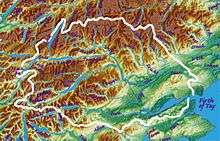
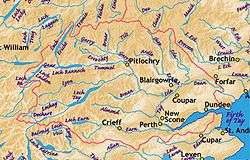
The Tay drains much of the lower region of the Highlands. It originates on the slopes of Ben Lui (Beinn Laoigh), only around 25 miles (40 km) from the west coast town of Oban, in Argyll and Bute.[1] In 2011, the Tay Western Catchments Partnership determined as its source (as based on its 'most dominant and longest' tributary) a small lochan on Allt Coire Laoigh south of the summit.[2] The river has a variety of names in its upper catchment: for the first few miles it is known as the River Connonish; then the River Fillan; the name then changes to the River Dochart until it flows into Loch Tay at Killin.
The River Tay emerges from Loch Tay at Kenmore, and flows from there to Perth which, in historical times, was its lowest bridging point. Below Perth the river becomes tidal and enters the Firth of Tay. The largest city on the river, Dundee, lies on the north bank of the Firth. On reaching the North Sea, the River Tay has flowed 120 miles (190 km) from west to east across central Scotland.
The Tay is unusual amongst Scottish rivers in having several major tributaries, notably the Earn, the Isla, the River Tummel, the Almond and the Lyon.[1]
A flow of 2,269 m3/s (80,100 cu ft/s) was recorded on 17 January 1993, when the river rose 6.48 m (21 ft 3 in) above its usual level at Perth, and caused extensive flooding in the city. Were it not for the hydro-electric schemes upstream which impounded runoff, the peak would have been considerably higher. The highest flood recorded at Perth occurred in 1814, when the river rose 7 m (23 ft) above its usual level, partly caused by a blockage of ice under Smeaton's Bridge. Other severe flood events occurred in 1210 and 1648 when bridges over the Tay at Perth were destroyed. During the winters of 2009–10 and 2010–11, the Tay froze over as far as the Tay Road Bridge, and ice floes remained for weeks despite a thaw.
Several places along the Tay take their names from it, or are believed to have done so:
Nature and conservation

The river is of high biodiversity value and is both a Site of Special Scientific Interest (SSSI) and a Special Area of Conservation. The SAC designation notes the river's importance for salmon (Salmo salar), otters (Lutra lutra), brook lampreys (Lampetra planeri), river lampreys (Lampetra fluviatilis), and sea lampreys (Petromyzon marinus) .[3] Tha Tay also maintains flagship population of Freshwater pearl mussel (Margaritifea margaritifera).[1] Freshwater pearl mussels are one of Scotland's most endangered species and the River Tay hosts two-thirds of the world's remaining stock.[4]
The Tay is internationally renowned for its salmon fishing and is one of the best salmon rivers in the United Kingdom, and western Europe, attracting anglers from all over the world. The lowest ten miles of the Tay, including prestigious beats like Taymount or Islamouth, provides most of the cream of the Tay. The largest rod caught salmon in Britain, caught on the Tay by Miss Georgina Ballantine in 1922, weighing 64 pounds (29 kg), retains the British record. The river system has salmon fisheries on many of its tributaries including the Earn, Isla, Ericht, Tummel, Garry, Dochart, Lyon and Eden.[5] Dwindling catches include a 50% reduction in 2009 so the Tay District Salmon Fisheries Board ordered a catch-and-release policy for females all season, and for males until May, beginning in the January 2010 fishing season. Research by the North Atlantic Salmon Conservation Organisation has shown that the number of salmon dying at sea has doubled or trebled over the past 20 years, possibly due to overfishing in the oceans where salmon spend two years before returning to freshwater to spawn. The widespread collapse in Atlantic salmon stocks suggests that this is not solely a local problem in the River Tay.[6]
A section of the Tay surrounding the town of Dunkeld is designated as a national scenic area (NSA),[7] one of 40 such areas in Scotland, which are defined so as to identify areas of exceptional scenery and to ensure its protection by restricting certain forms of development.[8] The River Tay (Dunkeld) NSA covers 5,708 ha.[9]
The first sustained and significant population Eurasian beaver (Castor fiber) living wild in Scotland in over 400 years became established on the river Tay catchment in Scotland as early as 2001, and has spread widely in the catchment, numbering from 20 to 100 individuals in 2011.[10] These beavers were likely to be either escapees from any of several nearby sites with captive beavers, or were illegally released, and were originally targeted for removal by Scottish Natural Heritage in late 2010.[11] Proponents of the beavers argued that no reason exists to believe that they are of "wrong" genetic stock.[10] In early December 2010, the first of the wild Tayside beavers was trapped by Scottish Natural Heritage on the River Ericht in Blairgowrie, Perthshire and was held in captivity in Edinburgh Zoo, dying within a few months.[12] In March 2012 the Scottish Government reversed the decision to remove beavers from the Tay, pending the outcome of studies into the suitability of re-introduction.[13]
As part of the study into re-introduction, a trial release project was undertaken in Knapdale, Argyll,[14][15][16] alongside which the population of beavers along the Tay was monitored and assessed.[13] Following the conclusion of the trial re-introduction, the Scottish Government announced in November 2016 that beavers could remain permanently, and would be given protected status as a native species within Scotland. Beavers will be allowed to extend their range naturally. To aid this process and improve the health and resilience of the population a further 28 beavers will be released in Knapdale between 2017 and 2020,[17] however there are no plans at present to release further beavers into the Tay.
Transport
In the 19th century the Tay Rail Bridge was built across the firth at Dundee as part of the East Coast Main Line, which linked Aberdeen in the north with Edinburgh and London to the south. The bridge, designed by Sir Thomas Bouch, officially opened in May 1878. On 28 December 1879 the bridge collapsed as a train passed over. The entire train fell into the firth, with the loss of 75 passengers and train crew. The event was commemorated in a poem, The Tay Bridge Disaster (1880), written by William McGonagall, a notoriously unskilled Scottish poet. The critical response to his article was enhanced as he had previously written two poems celebrating the strength and certain immortality of the Tay Bridge. A second much more well received poem was published in the same year by the German writer Theodor Fontane.[18] A. J. Cronin's first novel, Hatter's Castle (1931), includes a scene involving the Tay Bridge Disaster, and the 1942 filmed version of the book recreates the bridge's catastrophic collapse. The rail bridge was rebuilt, with the replacement bridge opening on 11 June 1887.
A passenger and vehicle ferry service operated across the River Tay between Craig Pier, Dundee and Newport-on-Tay in Fife. In Dundee, the ferries were known as "the Fifies".[19] The service was discontinued on the opening of the Tay Road Bridge on 18 August 1966.
The last vessels to operate the service were PS B. L. Nairn and two more modern ferries equipped with Voith Schneider Propellers, MVs Abercraig and Scotscraig.
Cultural references
The Tay is mentioned in William McGonagall's poems The Tay Bridge Disaster and Railway Bridge of the Silvery Tay and the German poet Theodor Fontane has mentioned the Tay in his poem Die Brück' am Tay. Both poems deal will the Tay bridge disaster of 1879 seeing the bridge's construction as a case of human hubris and expressing an uneasiness towards the fast technological development of mankind.[18] It is mentioned in the Steeleye Span song "The Royal Forester". Many Rolls-Royce civil aero-engines are named after British rivers, one of which is the Rolls-Royce Tay.
See also
References
- 1 2 3 4 River Tay, United Kingdom (PDF) (Report). Peer-Euraqua network of hydrological observatories. Retrieved 2010-12-29.
- ↑ "BBC News - Source of River Tay 'pinpointed'". BBC News.
- ↑ "Site Details for River Tay SAC". Scottish Natural Heritage. 2018-05-02. Retrieved 2018-05-21.
- ↑ River Tay Special Area of Conservation (PDF) (Report). Scottish Natural Heritage. Retrieved 2011-04-16.
- ↑ "Fish Tay". FishPal. 2011-01-11. Retrieved 2011-01-15.
- ↑ Frank Urquhart (11 January 2010). "In Scotland, Anglers Told to Put River Tay Salmon Back". Atlantic Salmon Federation. Archived from the original on 6 July 2011. Retrieved 15 January 2011.
- ↑ "Map: River Tay (Dunkeld) National Scenic Area" (PDF). Scottish Natural Heritage. December 2010. Retrieved 2018-05-21.
- ↑ "National Scenic Areas". Scottish Natural Heritage. Retrieved 2018-05-21.
- ↑ "National Scenic Areas - Maps". SNH. 2010-12-20. Retrieved 2018-05-21.
- 1 2 Duncan J. Halley (January 2011). "Sourcing Eurasian beaver Castor fiber stock for reintroductions in Great Britain and Western Europe". Mammal Review. 41: 40–53. doi:10.1111/j.1365-2907.2010.00167.x.
- ↑ Iain Howie (2010-12-03). "Perthshire beavers to be rounded up". Perthshire Advertiser. Retrieved 2010-12-29.
- ↑ "Sole trapped beaver Erica died in captivity". Courier News. 6 April 2011. Archived from the original on 7 April 2011. Retrieved 16 April 2011.
- 1 2 "Plan to trap River Tay beavers reversed by ministers". BBC News. 2012-03-16. Retrieved 2018-03-29.
- ↑ "UK | Scotland | Glasgow, Lanarkshire and West | Beavers to return after 400 years". BBC News. 2008-05-25. Retrieved 2010-03-15.
- ↑ "UK | Scotland | Glasgow, Lanarkshire and West | Beavers return after 400-year gap". BBC News. 2009-05-29. Retrieved 2010-03-15.
- ↑ "About the trial". www.scottishbeavers.org.uk. Retrieved 2017-04-14.
- ↑ "Beaver population increased in Knapdale". Scottish Wildlife Trust. 2017-11-28. Retrieved 2018-03-29.
- 1 2 Edward C. Smith III: The Collapse of the Tay Bridge: Theodor Fontane, William McGonagall, and the Poetic Response to the Humanity's First Technologocal Disaster. In: Ray Broadus Browne (ed.), Arthur G. Neal (ed.): Ordinary Reactions to Extraordinary Events. Popular Press (Ohio State University), 2001, ISBN 9780879728342, pp. 182-193
- ↑ "The Making of Modern Dundee" (PDF).
Gallery
_meets_the_River_Tay_-_geograph.org.uk_-_113846.jpg) Confluence of the Rivers Isla and Tay
Confluence of the Rivers Isla and Tay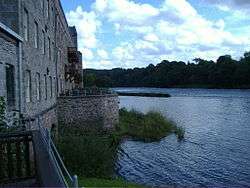 Stanley Mills
Stanley Mills Canoeists on the Tay at Stanley
Canoeists on the Tay at Stanley The Tay passing under Smeaton's Bridge in Perth
The Tay passing under Smeaton's Bridge in Perth Friarton Bridge, where the M90 motorway crosses the Tay
Friarton Bridge, where the M90 motorway crosses the Tay River Tay from Kinnoull Hill in Winter
River Tay from Kinnoull Hill in Winter Confluence of Rivers Earn (left) and Tay
Confluence of Rivers Earn (left) and Tay The Tay from Newburgh, Fife, showing Mugdrum Island
The Tay from Newburgh, Fife, showing Mugdrum Island
 River Tay near Longforgan
River Tay near Longforgan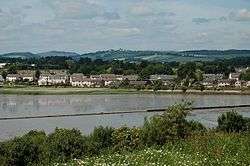 Invergowrie bay
Invergowrie bay The Tay Rail Bridge
The Tay Rail Bridge The Tay road bridge looking towards Fife
The Tay road bridge looking towards Fife
 Oil rig maintenance at Stannergate, Dundee
Oil rig maintenance at Stannergate, Dundee Broughty Ferry from Stannergate, Dundee
Broughty Ferry from Stannergate, Dundee Broughty Castle, Broughty Ferry
Broughty Castle, Broughty Ferry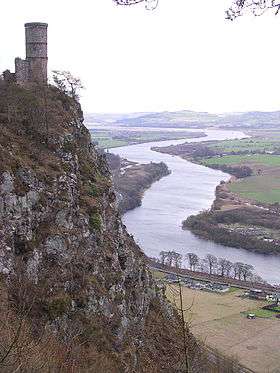 The Tay meandering its way east. Viewed from Kinnoull Hill in Perth.
The Tay meandering its way east. Viewed from Kinnoull Hill in Perth. View from Kinnoull Hill.
View from Kinnoull Hill. Alfred de Bréanski
Alfred de Bréanski
External links
- The Development of the Historic Burgh of Perth
- From the Ganga to the Tay by Bashabi Fraser, 2009. Luath Press Ltd. ISBN 1906307954.